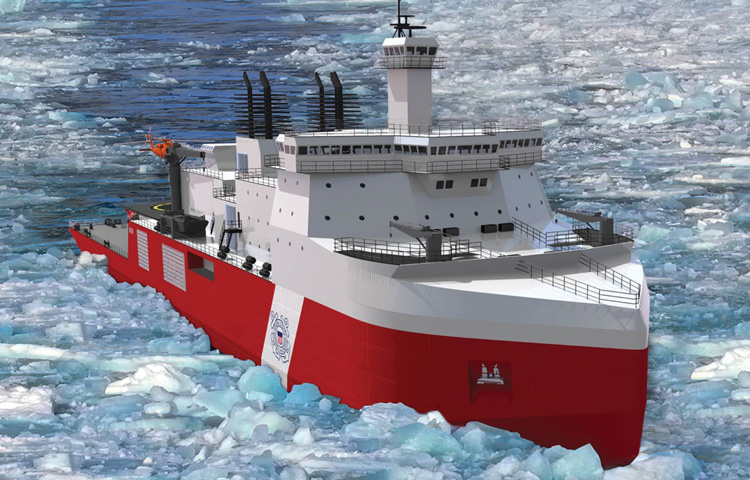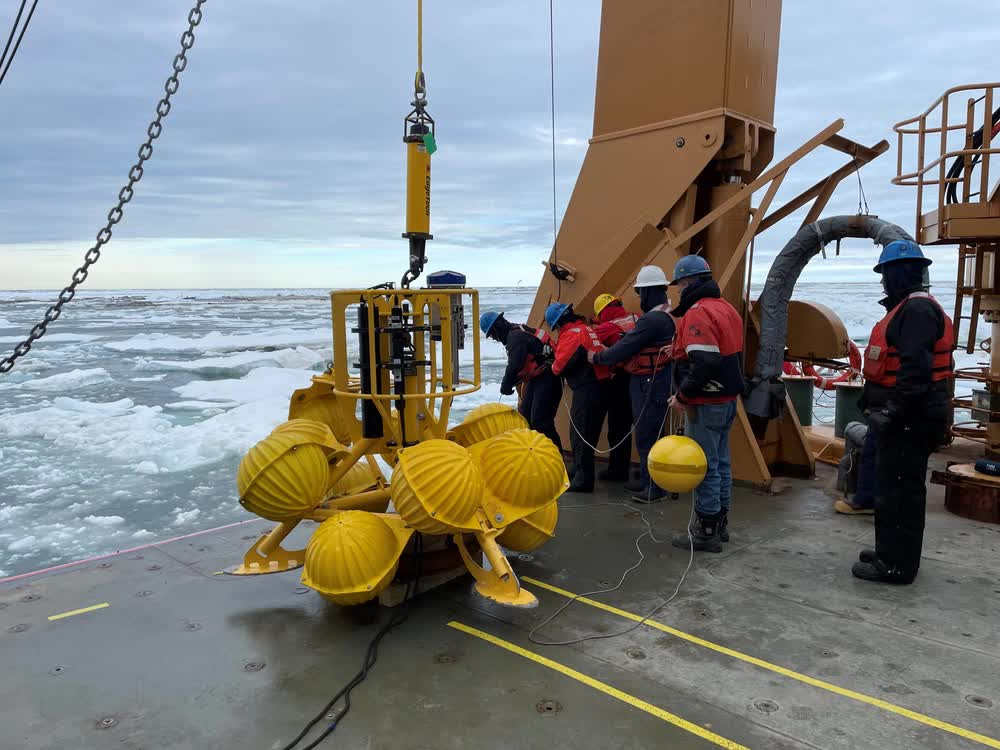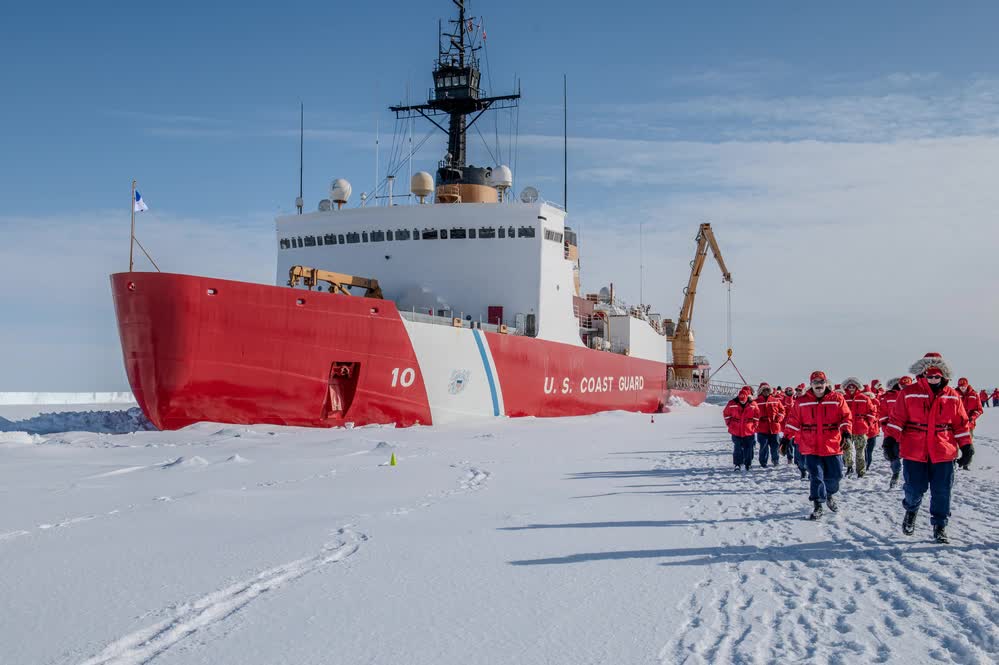Runaway costs and design delays: Are Coast Guard’s new icebreakers worth it?
- By Hope Seck
Share This Article

A new report issued this month by the Congressional Budget Office has the latest disappointing news for the U.S. Coast Guard’s effort to acquire new icebreaking ships. According to CBO’s new estimate, the three “Polar Security Cutters” the service wants to buy will cost $5.1 billion in current dollars, some 60 percent more than Coast Guard officials have estimated. And operating those ships through 2063 will cost the Coast Guard $12.4 billion. For context, that operating cost is a little less than the total cost of the U.S. Navy’s Gerald R. Ford supercarrier – but it’s also nearly the amount of the Coast Guard’s entire budget for 2024.
Fourteen years after the Coast Guard first identified a need to replace its aging icebreakers with a newer, more capable class of ships, and five years after it awarded the first contract for icebreaker design and construction, the acquisition process appears locked in a glacier. Congressional testimony this summer revealed that the design for the new Polar Security Cutter was only 67 percent finished after five years of work. While the Coast Guard was originally expected to receive its first of the three new icebreakers in 2025, construction is now only slated to begin this year, pushing the first delivery off to 2029.
“We are absolutely behind schedule,” Coast Guard Commandant Adm. Linda Fagan admitted to the House Committee on Homeland Security in July.
For all the lag and overrun of the new icebreaker program – the first of its kind in more than half a century – the Coast Guard maintains that it desperately needs the new ships to conduct missions in the icebound Arctic and Antarctic. The service’s current fleet has just two such ships: a heavy icebreaker, the Polar Star, which has now been in service 52 years; and a medium icebreaker, the Healy, which is newer but has had its share of mishaps. In July, the Healy suffered an electrical fire and was forced to scrap two scientific missions and a planned patrol through the Northwest passage that winds through the Arctic above North America.

And the need for new icebreakers is not exaggerated, said Rebecca Pincus, director of the Polar Institute at the Wilson Center in Washington, D.C.
“It is dire,” Pincus told Sandboxx News. “China has more icebreakers than we do, which is an embarrassment. And you know that the [U.S.’s] falling behind is just going to continue.”
China’s icebreaker superiority is especially troubling as the country does not even have any territory abutting the Arctic, as the U.S. and Russia do. China has described itself for more than half a decade as a “near-Arctic state,” a choice that its competitors believe is calculated to better allow it to make a claim on the region’s valuable and contested sea lanes.
China is on track to get its fourth icebreaking ship in 2025, and while all its icebreakers are outfitted as research vessels, it’s losing no opportunity to use them strategically. While the Healy was sidelined from its Arctic missions in July, China had deployed all three of its active icebreakers to the region. The message from the United States’ top global competitor is clear: We are here – even if you are not.
Russia’s icebreaker investments have been even more aggressive. With dozens of icebreakers in its fleet, the country has entered sea trials for its first “combat icebreaker,” a small, agile, and armed-to-the-teeth escort ship with launchers installed for anti-ship and cruise missiles.
The United States’ new Polar Security Cutters will come with some combat equipment. They’ll be 460 feet long compared to the Polar Star’s 399, and 22,900 long tons, more than double the Polar Star’s 10,863. They’ll reportedly be armed with a pair of 30mm autocannons for defense. When the design contract was first announced in 2019, then-Commandant Adm. Karl Schultz said the ships would also have a derivative of the Aegis Combat System, a centralized command-and-control system used on a range of Navy warships. But time to delivery remains critical.
Related: Tougher-than-nails Coast Guard rescue swimmers describe daring rescues

Pincus painted a picture of what a lapse in U.S. icebreaker capability could mean. American scientists would have to hitch rides on other countries’ ships to and from Antarctica’s McMurdo research station, she told Sandboxx News. Not only would this constitute a “symbolic embarrassment,” she said, but it could also become a crisis if no other country’s ship is available to do the favor.
On the national security side, American absence in the Arctic might leave competitors’ malign or threatening behavior unchecked.
“You can imagine a Chinese icebreaker up in the Arctic intruding into U.S. waters in the ice,” Pincus said. “We can fly a plane over it, we could drive a submarine underneath it, but we would have no ability to stop that ship… That, I think, is a real concern, because we know that China and Russia are poking and prodding to find weak spots and then trying to exploit them.”
And whether or not they smell blood in the ice water, China and Russia do appear to be intensifying activity in the region. A formation flight of two Russian and two Chinese bombers that flew through international airspace in the Arctic in July represented a troubling first for military collaboration in the region.
“You see them doing joint flights, sending icebreakers in,” Pincus said, “And I think they’re showing strength in an area where we do have a hard time countering that signal.”
The Coast Guard does have one stopgap icebreaking vessel en route as it builds up its new class. In August, it announced it would buy a commercial ship, the Aiviq, designed for offshore oil exploration. The icebreaker, which will cost about $125 million, is set to be stationed in Juneau, Alaska.
Feature Image: Render of the Polar Security cutter that is currently being designed for the Coast Guard. (U.S. Coast Guard)
Read more from Sandboxx News
- The implications of Ukraine’s invasion of Russia
- Ukraine needs free use of its powerful ATACMS to inflict maximum damage on Russia
- Live music as revival: Finding comfort in company
- Video: This is why the F-117 Nighthawk never retired
- The history of full-auto shotguns and why these weapons don’t make sense
Related Posts
Sandboxx News Merch
-

A-10 ‘Thunderbolt Power’ Framed Poster
$45.00 – $111.00 Select options This product has multiple variants. The options may be chosen on the product page -

‘Sandboxx News’ Camo Trucker Hat
$29.00 Select options This product has multiple variants. The options may be chosen on the product page
Hope Seck
Hope Hodge Seck is an award-winning investigative and enterprise reporter who has been covering military issues since 2009. She is the former managing editor for Military.com.
Related to: Military Affairs

Military draft registration is going down, so Congress wants to take action

How the military bounced back from the recruiting crisis
Sandboxx News
-

‘Sandboxx News’ Trucker Cap
$27.00 Select options This product has multiple variants. The options may be chosen on the product page -

‘AirPower’ Classic Hoodie
$46.00 – $48.00 Select options This product has multiple variants. The options may be chosen on the product page -

‘AirPower’ Golf Rope Hat
$31.00 Select options This product has multiple variants. The options may be chosen on the product page -

‘Sandboxx News’ Dad Hat
$27.00 Select options This product has multiple variants. The options may be chosen on the product page
